Papers by Karyn S Krawford
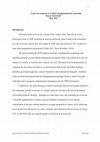
This study offers an overview of Inner West Council (IWC) and role as a local democratic entity i... more This study offers an overview of Inner West Council (IWC) and role as a local democratic entity in NSW including its function and broad values it adds to the community. It is one of twenty councils that was created by NSW State government in 2017 as part of a state-wide amalgamation programme (Uddin, 2017, Drew & Dollery, 2016).
The study critiques the NSW State government’s amalgamation programme and identifies potential reasons behind explanations provided by State Government as to why the number of councils in Australia have reduced over time. Research from broad perspectives critiquing the procedures and process is reported from both private and public institutes, including government agencies, councils themselves and communities impacted. Synthesis of the research demonstrates that the amalgamation programme failed to achieve its goals, with high costs to taxpayers and potential consequences for the NSW Government.
Furthermore, the study found government commercial interests can surpass benefits to the community and the occurrence in Council reduction coincides with current Australian Government political ideology. Strategies to create more cities, the increasing use of private “for profit” organisations to replace local governments community services and the centralisation of decision making and power to larger geographical centres, all of which may move ground level democracy to a more consumer and commercial driven society are found to be on the NSW State government agenda to reform local government.
Family & Relationship Counselling , 2020
Short overview of several academic articles on ethical issues therapists deal with
Critical Ethical Concerns That Arise in the Practice of Family Therapy, 2020
Micro level considerations for family and relationship counselling and therapy. Applications of ... more Micro level considerations for family and relationship counselling and therapy. Applications of Family Therapy from Psychodynamic to Strategic
An Overview Of Depression In Australia, 2019
Statistics of depression in Australia. Presented to academic student class.
Includes DSM 5 diagn... more Statistics of depression in Australia. Presented to academic student class.
Includes DSM 5 diagnosis and various types of Depression
Australian Mental Health Policy, 2019
Examination of the plan, strategy and implementation. Short overview and findings.
Mental Health Policy & Practice Australia, 2019
In 2011-2012, 95% of Australian homes used video game devices (SMH, 2012), with Australian consum... more In 2011-2012, 95% of Australian homes used video game devices (SMH, 2012), with Australian consumer spending $1.1 billion in 2012 on gaming devices alone (IGEA ,2013). This growing popularity of video games in Australia has meant a growth in the debate concerning the negative effects that video games can have on consumer’s mental health.
Gratification has been shown to affect the choice of video game play (Chory &Goodboy, 2011) and 43% of all video sales are violent video games (Entertainment Software Association website, 2013), so whether this is good for humanity or not.....
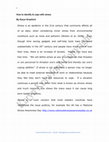
Weiten et al (2009) propose that stress is an epidemic in the 21st century that commonly affects ... more Weiten et al (2009) propose that stress is an epidemic in the 21st century that commonly affects all of us on a daily basis, when considering minor stress from environmental conditions such as noise and pollution. Even though time saving gadgets and self help tools have increased substantially in the 20th century and people have more control over their lives, there is an increase of anxiety and people have less free time. “We will define stress as any circumstances that threaten or are perceived to threaten one’s well-being and thereby tax one’s coping abilities”. (Pg 71). For example a person can no longer meet external demands such as work or relationships because they feel they do not have the resources to cope. Chronic stress is in the eye of the beholder.
Stress is of such concern that the UK now recognises ‘National Stress Awareness Day’ (http://www.nationalstressawarenessday.co.uk).
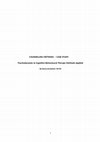
Introduction
The psychodynamic group consists of four main therapies; Freud's psychoanalytic ap... more Introduction
The psychodynamic group consists of four main therapies; Freud's psychoanalytic approach, Jungian, Adlerian and Object Relations. The therapist is focused on personality reconstruction, gaining insight to unconscious motivations and suppressed materials predominately relating to early childhood. "The basic psychodynamics of the person are established early in life during the stages of psychosexual development. The role of subsequent experiences is determined by the motivational patterns established in early childhood (Mischel, 1971, pg.51).
The cognitive-behavioural group consists of four behavioural treatment therapies; Behavioural Modification, Cognitive-Behavioural, Rational Emotive Behavioural and Reality Therapy. Behavioural therapists are concerned with the belief systems and thinking process causing the dysfunctional behaviour, which is treated through client's action. "Cognitive therapies assume that distortions in a person's thoughts and beliefs (cognition's) can lead to a number of mental health problems including depression and anxiety" (Robinson, 2000, pg.19).
I have examined perspectives of Richard who has been referred to a psychotherapist after being convicted of drunk driving. He is 25 yrs old, experiences high anxiety, depression and has had suicidal thoughts. Additionally he cannot establish close relationships to others and is fearful of certain types of women. He remembers a rough family life and suffers from low self-esteem, thinking he is better off dead which is what his mother used to say to him.
By assuming the role of the therapist I apply techniques from each therapy most helpful to individual issues mentioned in the case study. I have included points on the therapist's character, as I believe this would determine the effectiveness of the outcome, timeframe and application strength of each technique used. In the conclusion I have put together main points to explain my reasoning.
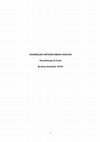
Introduction
Psychoanalytic therapy is based on insight, unconscious motivation and
personalit... more Introduction
Psychoanalytic therapy is based on insight, unconscious motivation and
personality reconstruction. Isbister (1985) quotes "Man can stretch
himself as he may with his knowledge and appear to himself as objective
as he may; in the last analysis he gives nothing but his own biography
(F.Nietzsche)" (pg. 43).
The influential Sigmund Freud continues to impact psychoanalysis with his
theories on human nature that is determined from the first 6 years of life
by biological and instinctual drivers which are considered to be our unconscious motivations.
Freud believes we can transcend the unconscious through to the conscious
in order to make choices from heightened awareness rather than responding from blind habit.
According to Freud, our personalities are basically made up of three structures that he calls ID, Ego and Superego. Corey (2001) explains Freud's theory "The id is the biological component, the ego is the psychological component and the superego is the social component" (pg. 69). Of these structures, the ID is the part of our mind that governs our primal instinctual drives of which makes up the unconscious. The unconscious consists of experiences and memories, which have been suppressed, as they were too painful to be consciously bought into awareness. Corey (2001) explains how our ego defence mechanisms operate; "Freud explained repression as an involuntary removal of
something from consciousness. It is assumed that the most painful events of the first 5 years of life are so excluded, yet these events do influence later behaviour"(pg. 71). The repressed material can be difficult to accept in the conscious mind for what it represents which is commonly manifested in the form of symbols in a dream. Corey (2001) explains, "the unconscious sexual and aggressive impulses that make up 'latent content' are transformed into the more acceptable manifest content' which is the dream as it appears to the dreamer" (Pg. 71,72). Freud's psychoanalytic method of analysing dreams is called 'free association'.
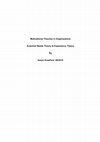
Introduction
People are motivated to work by an internal force that drives a person’s persiste... more Introduction
People are motivated to work by an internal force that drives a person’s persistence, direction and effort to work (Wood et al, 2010), satisfying the intrinsic and extrinsic needs people have such as money and security. Needs are desired to be met when either a bodily or psychological tension is needed to be satisfied (Thrash & Elliot, 2001).
In organizations, motivating people is a highly researched subject as it contributes to both the quality of working life and the productivity of the organization (Wood et al, pg 78). Consequently, managers must perform a vital role of identifying what motivates an individual, create an environment to positively support and meet the needs of employees.
Of the many motivational theories, this essay examines the use of two of them and how they can be used in organizations. McClelland’s Acquired Needs Theory can be used to profile people into suitable jobs and Victor Vroom’s Expectancy Theory can help motivate people by reward success opportunities. While these theories do not explain motivation as a biological or psychological phenomenon, they were chosen for their proven value to motivate people in the workplace. Together they provide valuable insight into human behaviour and can help managers understand and motivate individuals thereby increasing job performance.
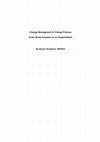
Introduction
This case study focuses on a fast growing online business services startup platform... more Introduction
This case study focuses on a fast growing online business services startup platform in Australia. It operates as its own functioning business unit under the umbrella of News Ltd, who own a cluster of individual digital companies also known as Rupert Murdoch’s News Corporation, one of the world’s largest global media companies. This case study examines a change that occurred when almost the entire senior management staff level was replaced including the CEO two years ago.
Organisational change is something that occurs throughout an organisation’s life cycle and effects the entire organisation rather than one part of it. Employing a new person is one example. Change is increasing due to a number of forces including globalisation led by rapidly advancing technologies, cultural diversity, environmental resources and the economy; therefore the ability to recognise the need for change as well as implement change strategies effectively, in a proactive response to internal and external pressures is essential to organisational performance. Internal changes can include organisational structure, process and HR requirements and external changes involve government legislation, competitor movements and customer demand (Wood et al, 2010).
Change does not need to be a painful process, as it may seem when observing the amount of failed change management initiatives with reports as low as 10% of researched success rates (Oakland & Tanner, 2007), when successful change management strategies are utilised and planned, including effective communication strategies, operational alignment, readiness to change and implementation, which all lower and overcome resistance (Wood et al, 2010).
There is a great amount of literature on the negative aspects and difficult management with employees resisting change, however Wood et al (2010) challenge this notion by questioning the change management process as people do not resist change itself but aspects of the change that affects them personally such as fear of the unknown, status, remuneration and comfort. Resistance to these changes is a healthy reaction and can be managed effectively in the beginning by ensuring communication and using one of the change initiatives described here .
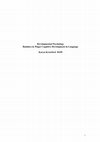
One of the most important developmental stages children progress through and one of which we some... more One of the most important developmental stages children progress through and one of which we sometimes take for granted, is learning to speak language. Children begin to speak not long after they are born and continue to develop this highly complex skill to communicate. Children are very intelligent; in fact most children can speak before walking and master many language elements in infancy (Sigelman & Rider, 2009)
In this essay I describe my own developmental experience of learning to speak a language and provide an overview of two well-known developmental theories, J.Piaget’s Cognitive Developmental theory and Albert Bandura’s Social Cognitive Theory, approaches to human development. These two approaches I have analysed in relation to my developmental milestone.
Both theorists explain human development occurs through an interaction of ‘Nature/Nurture’, a well debated concept after overwhelming research showed people are not born a ‘blank slate’ as once believed, shaped entirely by the environment, but genes are inherited through parents which then interact with the environment, making humanity a product of both biological and environmental factors (Bandura, 1989, Huitt & Hummel, 2003).
I explain differences between the two theorists, both of which contribute well-researched experimental and scientific work in lifespan development and my essay concludes that when learning language the environment influenced me more than a biological predisposition. Ultimately my research shows environment has the largest impact on how well and how soon people learn to communicate through language.
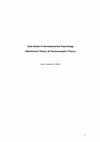
Childhood relationships and behavioural theories based on undesirable inherited characteristics h... more Childhood relationships and behavioural theories based on undesirable inherited characteristics has in the past sent confusing messages to both the general public and government agencies until a breakthrough in reliable, statistical and verifiable empirical based research became available called attachment theories. Since then parenting styles and childhood continue to receive a high priority of investigation to help understand a person’s behaviour (Karen, 1994).
Two theories in developmental psychology that are both predictors of how and why people form close relationships with others over their lifespan are Attachment theory and Psychoanalytic theory of which both show that family life and childhood relationships are strong predictors of the types of relationships people form in life and their relating styles.
This case study was conducted to replicate these findings by interviewing a person currently experiencing a relationship problem, on the dynamics of the relationship, past relationships, childhood and family.
This case study shows that while temperament may be a genetic predisposition, emotional and relating styles a person uses correlate with strongly supported, empirical based research on the formation of early relationships that began with caregivers and is passed down through the generations (Karen, 1994; Sigelman & Rider, 2009).
The term ‘culture’ is considered notoriously ambiguous, complex whole, encompassing almost everyt... more The term ‘culture’ is considered notoriously ambiguous, complex whole, encompassing almost everything (Sardar & Van Loon, 2004), of which has no operational definition, however most common meaning is the pattern of beliefs, values, habits, ideals, and preferences shared by both small and large groups of people. These cultural characteristics learned in early childhood are mostly unconscious and vital as they have more effect than later influences (Jones, 2006).
Despite the challenge in defining the word, Sardar & Van Loon (2004) note cultural studies use a variety of disciplines such as Anthropology, Psychology, Linguistics, and Literary criticism, Art Theory, Musicology, Philosophy and Political Science.
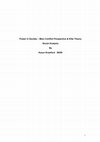
Power is present in each individual and in every relationship. It is defined as the ability of a... more Power is present in each individual and in every relationship. It is defined as the ability of a group to get another group to take some form of desired action, usually by consensual power and sometimes by force (Holmes, Hughes & Julian, 2007).
In society governments, organisations and an elite class of people make decisions that affect the lives of a large mass of other people. A significant amount of research shows these decisions are often made to serve their own economic interests and values of which includes the means of production and property ownership (Holmes et al, 2007; Walters & Crook, 1995; Haralambos & Holborn, 1990; McGregor, 2000).
These decisions cause inequality in society and resentment from people who are excluded from the decision making process. The unequalness of this decision-making and power allocation enables the fortunate to enforce their will on the less fortunate (Graetz, 2001, Walters & Crook, 1995).
This essay discusses power from two sociological views; the Conflict perspective, predominately from Karl Marx and the Elite theory perspective. These theories show that power is distributed unequally in society where governments, a ruling class, media and business elites hold the majority of power over others.
This report is based on what I have observed of the function, dynamics, components and developmen... more This report is based on what I have observed of the function, dynamics, components and development of a group within a large organisation. I have observed the group by attending meetings, observing communication and behaviours of members and group interaction with the organisation.
Bundey et al (undated) define the term ‘dynamics’ from a physics definition is forces that act and resulting change “when we talk about ‘group dynamics’ we are concerned with what it is that causes, or helps to cause, what we observe happening in our groups.” (Pg B59).






Uploads
Papers by Karyn S Krawford
The study critiques the NSW State government’s amalgamation programme and identifies potential reasons behind explanations provided by State Government as to why the number of councils in Australia have reduced over time. Research from broad perspectives critiquing the procedures and process is reported from both private and public institutes, including government agencies, councils themselves and communities impacted. Synthesis of the research demonstrates that the amalgamation programme failed to achieve its goals, with high costs to taxpayers and potential consequences for the NSW Government.
Furthermore, the study found government commercial interests can surpass benefits to the community and the occurrence in Council reduction coincides with current Australian Government political ideology. Strategies to create more cities, the increasing use of private “for profit” organisations to replace local governments community services and the centralisation of decision making and power to larger geographical centres, all of which may move ground level democracy to a more consumer and commercial driven society are found to be on the NSW State government agenda to reform local government.
Includes DSM 5 diagnosis and various types of Depression
Gratification has been shown to affect the choice of video game play (Chory &Goodboy, 2011) and 43% of all video sales are violent video games (Entertainment Software Association website, 2013), so whether this is good for humanity or not.....
Stress is of such concern that the UK now recognises ‘National Stress Awareness Day’ (http://www.nationalstressawarenessday.co.uk).
The psychodynamic group consists of four main therapies; Freud's psychoanalytic approach, Jungian, Adlerian and Object Relations. The therapist is focused on personality reconstruction, gaining insight to unconscious motivations and suppressed materials predominately relating to early childhood. "The basic psychodynamics of the person are established early in life during the stages of psychosexual development. The role of subsequent experiences is determined by the motivational patterns established in early childhood (Mischel, 1971, pg.51).
The cognitive-behavioural group consists of four behavioural treatment therapies; Behavioural Modification, Cognitive-Behavioural, Rational Emotive Behavioural and Reality Therapy. Behavioural therapists are concerned with the belief systems and thinking process causing the dysfunctional behaviour, which is treated through client's action. "Cognitive therapies assume that distortions in a person's thoughts and beliefs (cognition's) can lead to a number of mental health problems including depression and anxiety" (Robinson, 2000, pg.19).
I have examined perspectives of Richard who has been referred to a psychotherapist after being convicted of drunk driving. He is 25 yrs old, experiences high anxiety, depression and has had suicidal thoughts. Additionally he cannot establish close relationships to others and is fearful of certain types of women. He remembers a rough family life and suffers from low self-esteem, thinking he is better off dead which is what his mother used to say to him.
By assuming the role of the therapist I apply techniques from each therapy most helpful to individual issues mentioned in the case study. I have included points on the therapist's character, as I believe this would determine the effectiveness of the outcome, timeframe and application strength of each technique used. In the conclusion I have put together main points to explain my reasoning.
Psychoanalytic therapy is based on insight, unconscious motivation and
personality reconstruction. Isbister (1985) quotes "Man can stretch
himself as he may with his knowledge and appear to himself as objective
as he may; in the last analysis he gives nothing but his own biography
(F.Nietzsche)" (pg. 43).
The influential Sigmund Freud continues to impact psychoanalysis with his
theories on human nature that is determined from the first 6 years of life
by biological and instinctual drivers which are considered to be our unconscious motivations.
Freud believes we can transcend the unconscious through to the conscious
in order to make choices from heightened awareness rather than responding from blind habit.
According to Freud, our personalities are basically made up of three structures that he calls ID, Ego and Superego. Corey (2001) explains Freud's theory "The id is the biological component, the ego is the psychological component and the superego is the social component" (pg. 69). Of these structures, the ID is the part of our mind that governs our primal instinctual drives of which makes up the unconscious. The unconscious consists of experiences and memories, which have been suppressed, as they were too painful to be consciously bought into awareness. Corey (2001) explains how our ego defence mechanisms operate; "Freud explained repression as an involuntary removal of
something from consciousness. It is assumed that the most painful events of the first 5 years of life are so excluded, yet these events do influence later behaviour"(pg. 71). The repressed material can be difficult to accept in the conscious mind for what it represents which is commonly manifested in the form of symbols in a dream. Corey (2001) explains, "the unconscious sexual and aggressive impulses that make up 'latent content' are transformed into the more acceptable manifest content' which is the dream as it appears to the dreamer" (Pg. 71,72). Freud's psychoanalytic method of analysing dreams is called 'free association'.
People are motivated to work by an internal force that drives a person’s persistence, direction and effort to work (Wood et al, 2010), satisfying the intrinsic and extrinsic needs people have such as money and security. Needs are desired to be met when either a bodily or psychological tension is needed to be satisfied (Thrash & Elliot, 2001).
In organizations, motivating people is a highly researched subject as it contributes to both the quality of working life and the productivity of the organization (Wood et al, pg 78). Consequently, managers must perform a vital role of identifying what motivates an individual, create an environment to positively support and meet the needs of employees.
Of the many motivational theories, this essay examines the use of two of them and how they can be used in organizations. McClelland’s Acquired Needs Theory can be used to profile people into suitable jobs and Victor Vroom’s Expectancy Theory can help motivate people by reward success opportunities. While these theories do not explain motivation as a biological or psychological phenomenon, they were chosen for their proven value to motivate people in the workplace. Together they provide valuable insight into human behaviour and can help managers understand and motivate individuals thereby increasing job performance.
This case study focuses on a fast growing online business services startup platform in Australia. It operates as its own functioning business unit under the umbrella of News Ltd, who own a cluster of individual digital companies also known as Rupert Murdoch’s News Corporation, one of the world’s largest global media companies. This case study examines a change that occurred when almost the entire senior management staff level was replaced including the CEO two years ago.
Organisational change is something that occurs throughout an organisation’s life cycle and effects the entire organisation rather than one part of it. Employing a new person is one example. Change is increasing due to a number of forces including globalisation led by rapidly advancing technologies, cultural diversity, environmental resources and the economy; therefore the ability to recognise the need for change as well as implement change strategies effectively, in a proactive response to internal and external pressures is essential to organisational performance. Internal changes can include organisational structure, process and HR requirements and external changes involve government legislation, competitor movements and customer demand (Wood et al, 2010).
Change does not need to be a painful process, as it may seem when observing the amount of failed change management initiatives with reports as low as 10% of researched success rates (Oakland & Tanner, 2007), when successful change management strategies are utilised and planned, including effective communication strategies, operational alignment, readiness to change and implementation, which all lower and overcome resistance (Wood et al, 2010).
There is a great amount of literature on the negative aspects and difficult management with employees resisting change, however Wood et al (2010) challenge this notion by questioning the change management process as people do not resist change itself but aspects of the change that affects them personally such as fear of the unknown, status, remuneration and comfort. Resistance to these changes is a healthy reaction and can be managed effectively in the beginning by ensuring communication and using one of the change initiatives described here .
In this essay I describe my own developmental experience of learning to speak a language and provide an overview of two well-known developmental theories, J.Piaget’s Cognitive Developmental theory and Albert Bandura’s Social Cognitive Theory, approaches to human development. These two approaches I have analysed in relation to my developmental milestone.
Both theorists explain human development occurs through an interaction of ‘Nature/Nurture’, a well debated concept after overwhelming research showed people are not born a ‘blank slate’ as once believed, shaped entirely by the environment, but genes are inherited through parents which then interact with the environment, making humanity a product of both biological and environmental factors (Bandura, 1989, Huitt & Hummel, 2003).
I explain differences between the two theorists, both of which contribute well-researched experimental and scientific work in lifespan development and my essay concludes that when learning language the environment influenced me more than a biological predisposition. Ultimately my research shows environment has the largest impact on how well and how soon people learn to communicate through language.
Two theories in developmental psychology that are both predictors of how and why people form close relationships with others over their lifespan are Attachment theory and Psychoanalytic theory of which both show that family life and childhood relationships are strong predictors of the types of relationships people form in life and their relating styles.
This case study was conducted to replicate these findings by interviewing a person currently experiencing a relationship problem, on the dynamics of the relationship, past relationships, childhood and family.
This case study shows that while temperament may be a genetic predisposition, emotional and relating styles a person uses correlate with strongly supported, empirical based research on the formation of early relationships that began with caregivers and is passed down through the generations (Karen, 1994; Sigelman & Rider, 2009).
Despite the challenge in defining the word, Sardar & Van Loon (2004) note cultural studies use a variety of disciplines such as Anthropology, Psychology, Linguistics, and Literary criticism, Art Theory, Musicology, Philosophy and Political Science.
In society governments, organisations and an elite class of people make decisions that affect the lives of a large mass of other people. A significant amount of research shows these decisions are often made to serve their own economic interests and values of which includes the means of production and property ownership (Holmes et al, 2007; Walters & Crook, 1995; Haralambos & Holborn, 1990; McGregor, 2000).
These decisions cause inequality in society and resentment from people who are excluded from the decision making process. The unequalness of this decision-making and power allocation enables the fortunate to enforce their will on the less fortunate (Graetz, 2001, Walters & Crook, 1995).
This essay discusses power from two sociological views; the Conflict perspective, predominately from Karl Marx and the Elite theory perspective. These theories show that power is distributed unequally in society where governments, a ruling class, media and business elites hold the majority of power over others.
Bundey et al (undated) define the term ‘dynamics’ from a physics definition is forces that act and resulting change “when we talk about ‘group dynamics’ we are concerned with what it is that causes, or helps to cause, what we observe happening in our groups.” (Pg B59).
The study critiques the NSW State government’s amalgamation programme and identifies potential reasons behind explanations provided by State Government as to why the number of councils in Australia have reduced over time. Research from broad perspectives critiquing the procedures and process is reported from both private and public institutes, including government agencies, councils themselves and communities impacted. Synthesis of the research demonstrates that the amalgamation programme failed to achieve its goals, with high costs to taxpayers and potential consequences for the NSW Government.
Furthermore, the study found government commercial interests can surpass benefits to the community and the occurrence in Council reduction coincides with current Australian Government political ideology. Strategies to create more cities, the increasing use of private “for profit” organisations to replace local governments community services and the centralisation of decision making and power to larger geographical centres, all of which may move ground level democracy to a more consumer and commercial driven society are found to be on the NSW State government agenda to reform local government.
Includes DSM 5 diagnosis and various types of Depression
Gratification has been shown to affect the choice of video game play (Chory &Goodboy, 2011) and 43% of all video sales are violent video games (Entertainment Software Association website, 2013), so whether this is good for humanity or not.....
Stress is of such concern that the UK now recognises ‘National Stress Awareness Day’ (http://www.nationalstressawarenessday.co.uk).
The psychodynamic group consists of four main therapies; Freud's psychoanalytic approach, Jungian, Adlerian and Object Relations. The therapist is focused on personality reconstruction, gaining insight to unconscious motivations and suppressed materials predominately relating to early childhood. "The basic psychodynamics of the person are established early in life during the stages of psychosexual development. The role of subsequent experiences is determined by the motivational patterns established in early childhood (Mischel, 1971, pg.51).
The cognitive-behavioural group consists of four behavioural treatment therapies; Behavioural Modification, Cognitive-Behavioural, Rational Emotive Behavioural and Reality Therapy. Behavioural therapists are concerned with the belief systems and thinking process causing the dysfunctional behaviour, which is treated through client's action. "Cognitive therapies assume that distortions in a person's thoughts and beliefs (cognition's) can lead to a number of mental health problems including depression and anxiety" (Robinson, 2000, pg.19).
I have examined perspectives of Richard who has been referred to a psychotherapist after being convicted of drunk driving. He is 25 yrs old, experiences high anxiety, depression and has had suicidal thoughts. Additionally he cannot establish close relationships to others and is fearful of certain types of women. He remembers a rough family life and suffers from low self-esteem, thinking he is better off dead which is what his mother used to say to him.
By assuming the role of the therapist I apply techniques from each therapy most helpful to individual issues mentioned in the case study. I have included points on the therapist's character, as I believe this would determine the effectiveness of the outcome, timeframe and application strength of each technique used. In the conclusion I have put together main points to explain my reasoning.
Psychoanalytic therapy is based on insight, unconscious motivation and
personality reconstruction. Isbister (1985) quotes "Man can stretch
himself as he may with his knowledge and appear to himself as objective
as he may; in the last analysis he gives nothing but his own biography
(F.Nietzsche)" (pg. 43).
The influential Sigmund Freud continues to impact psychoanalysis with his
theories on human nature that is determined from the first 6 years of life
by biological and instinctual drivers which are considered to be our unconscious motivations.
Freud believes we can transcend the unconscious through to the conscious
in order to make choices from heightened awareness rather than responding from blind habit.
According to Freud, our personalities are basically made up of three structures that he calls ID, Ego and Superego. Corey (2001) explains Freud's theory "The id is the biological component, the ego is the psychological component and the superego is the social component" (pg. 69). Of these structures, the ID is the part of our mind that governs our primal instinctual drives of which makes up the unconscious. The unconscious consists of experiences and memories, which have been suppressed, as they were too painful to be consciously bought into awareness. Corey (2001) explains how our ego defence mechanisms operate; "Freud explained repression as an involuntary removal of
something from consciousness. It is assumed that the most painful events of the first 5 years of life are so excluded, yet these events do influence later behaviour"(pg. 71). The repressed material can be difficult to accept in the conscious mind for what it represents which is commonly manifested in the form of symbols in a dream. Corey (2001) explains, "the unconscious sexual and aggressive impulses that make up 'latent content' are transformed into the more acceptable manifest content' which is the dream as it appears to the dreamer" (Pg. 71,72). Freud's psychoanalytic method of analysing dreams is called 'free association'.
People are motivated to work by an internal force that drives a person’s persistence, direction and effort to work (Wood et al, 2010), satisfying the intrinsic and extrinsic needs people have such as money and security. Needs are desired to be met when either a bodily or psychological tension is needed to be satisfied (Thrash & Elliot, 2001).
In organizations, motivating people is a highly researched subject as it contributes to both the quality of working life and the productivity of the organization (Wood et al, pg 78). Consequently, managers must perform a vital role of identifying what motivates an individual, create an environment to positively support and meet the needs of employees.
Of the many motivational theories, this essay examines the use of two of them and how they can be used in organizations. McClelland’s Acquired Needs Theory can be used to profile people into suitable jobs and Victor Vroom’s Expectancy Theory can help motivate people by reward success opportunities. While these theories do not explain motivation as a biological or psychological phenomenon, they were chosen for their proven value to motivate people in the workplace. Together they provide valuable insight into human behaviour and can help managers understand and motivate individuals thereby increasing job performance.
This case study focuses on a fast growing online business services startup platform in Australia. It operates as its own functioning business unit under the umbrella of News Ltd, who own a cluster of individual digital companies also known as Rupert Murdoch’s News Corporation, one of the world’s largest global media companies. This case study examines a change that occurred when almost the entire senior management staff level was replaced including the CEO two years ago.
Organisational change is something that occurs throughout an organisation’s life cycle and effects the entire organisation rather than one part of it. Employing a new person is one example. Change is increasing due to a number of forces including globalisation led by rapidly advancing technologies, cultural diversity, environmental resources and the economy; therefore the ability to recognise the need for change as well as implement change strategies effectively, in a proactive response to internal and external pressures is essential to organisational performance. Internal changes can include organisational structure, process and HR requirements and external changes involve government legislation, competitor movements and customer demand (Wood et al, 2010).
Change does not need to be a painful process, as it may seem when observing the amount of failed change management initiatives with reports as low as 10% of researched success rates (Oakland & Tanner, 2007), when successful change management strategies are utilised and planned, including effective communication strategies, operational alignment, readiness to change and implementation, which all lower and overcome resistance (Wood et al, 2010).
There is a great amount of literature on the negative aspects and difficult management with employees resisting change, however Wood et al (2010) challenge this notion by questioning the change management process as people do not resist change itself but aspects of the change that affects them personally such as fear of the unknown, status, remuneration and comfort. Resistance to these changes is a healthy reaction and can be managed effectively in the beginning by ensuring communication and using one of the change initiatives described here .
In this essay I describe my own developmental experience of learning to speak a language and provide an overview of two well-known developmental theories, J.Piaget’s Cognitive Developmental theory and Albert Bandura’s Social Cognitive Theory, approaches to human development. These two approaches I have analysed in relation to my developmental milestone.
Both theorists explain human development occurs through an interaction of ‘Nature/Nurture’, a well debated concept after overwhelming research showed people are not born a ‘blank slate’ as once believed, shaped entirely by the environment, but genes are inherited through parents which then interact with the environment, making humanity a product of both biological and environmental factors (Bandura, 1989, Huitt & Hummel, 2003).
I explain differences between the two theorists, both of which contribute well-researched experimental and scientific work in lifespan development and my essay concludes that when learning language the environment influenced me more than a biological predisposition. Ultimately my research shows environment has the largest impact on how well and how soon people learn to communicate through language.
Two theories in developmental psychology that are both predictors of how and why people form close relationships with others over their lifespan are Attachment theory and Psychoanalytic theory of which both show that family life and childhood relationships are strong predictors of the types of relationships people form in life and their relating styles.
This case study was conducted to replicate these findings by interviewing a person currently experiencing a relationship problem, on the dynamics of the relationship, past relationships, childhood and family.
This case study shows that while temperament may be a genetic predisposition, emotional and relating styles a person uses correlate with strongly supported, empirical based research on the formation of early relationships that began with caregivers and is passed down through the generations (Karen, 1994; Sigelman & Rider, 2009).
Despite the challenge in defining the word, Sardar & Van Loon (2004) note cultural studies use a variety of disciplines such as Anthropology, Psychology, Linguistics, and Literary criticism, Art Theory, Musicology, Philosophy and Political Science.
In society governments, organisations and an elite class of people make decisions that affect the lives of a large mass of other people. A significant amount of research shows these decisions are often made to serve their own economic interests and values of which includes the means of production and property ownership (Holmes et al, 2007; Walters & Crook, 1995; Haralambos & Holborn, 1990; McGregor, 2000).
These decisions cause inequality in society and resentment from people who are excluded from the decision making process. The unequalness of this decision-making and power allocation enables the fortunate to enforce their will on the less fortunate (Graetz, 2001, Walters & Crook, 1995).
This essay discusses power from two sociological views; the Conflict perspective, predominately from Karl Marx and the Elite theory perspective. These theories show that power is distributed unequally in society where governments, a ruling class, media and business elites hold the majority of power over others.
Bundey et al (undated) define the term ‘dynamics’ from a physics definition is forces that act and resulting change “when we talk about ‘group dynamics’ we are concerned with what it is that causes, or helps to cause, what we observe happening in our groups.” (Pg B59).
Power
Control, Power & Money
All or Nothing – Scarcity Power Plays
Intimidation
Metaphors
Lies
Ways to Respond
4 stages of cognitive development
Problems with Piaget’s theory
Beyond Piaget
Post formal thought
Vygotsky’s sociocultural model
The effect of aging on cognitive abilities
Language development – key theories
Sociocultural studies
Learning – classical & operant conditioning + observational learning
My position on the subject and how this affects the content.
Presentation includes;
Bowlby – Attachment Theory
Styles & characteristics of Attachment Theory
Sternberg’s Triangular Theory of Love
Close Romantic Relationships Research Report
Ending Relationships
References
The need for recognition
Programming & Benefits of Games
Games – definitions A, B & C
Power Plays – definition & classification
Discussion about both
Small group discussion of experience
Close & feedback
Games – definitions A, B & C
Power Plays – definition & classification
Discussion about both
Small group discussion of experience
Close & feedback
HYPOTHESIS
HISTORICAL SOCIOLOGICAL WAVES
4TH WAVE PREDICTION
THE CURRENT PICTURE NOW
3 PROCESS GOING ON NOW
2 PATHS TO TAKE
A STORY
VIRTUAL REALITY
FUTURE PREDICTIONS OF TECHNOLOGICAL EVOLUTION
CYBERNETICS
PAR (PASSIVE/ACTIVE RATIO)
EMOTIONAL INTELLIGENCE
INFO AGE & MENTAL HEALTH
ECOLOGICAL CONSEQUENCES
INFORMATION
NATURE/NUTRURE
WHAT IS INFORMATION – A SCIENTIFIC DEFINITION
QUALITY OF INFORMATION
TELEVISION
VIDEO GAMES
AREAS NOT COVERED IN THIS PRESENTATION
CYBER PSYCHOLOGY
Historical technology effects and consequences
Claude Steiner’s view of Psychological effects
Television
Effects on Mental Health
Memory & Brain
Cyber Bullying
Empathy
Internet Addiction
Passive/Active Ratio
CYBER SOCIOLOGY
Historical
Social Movements
Twitter
Walling off the Internet
Organisations
Apple
Power
Facebook
Net Neutrality
Politial control
Free speech
Website attacks
China
Web Filtering
Future of the Internet
Security
Transperancy
Virtual Reality
Nanotechnology
Nano ethics
Debates
Future Plans
Gamification
In 1978 NASA took advantage of this discovery by using Process Communication in the selection, placement, and training of astronauts. Today, tens of thousands of people, from astronauts to entrepreneurs, have put these distinctions to work for themselves.
What are Drivers?
They are programmed responses to messages we carry from important people in our past
Unconscious attempts by us to behave in ways that gain us recognition
Drivers are myths, we believe they will result in feeling better ourselves
Never enough, leads to stress and a never ending cycle
Where are Drivers Used?
Workplace – managers, workers productivity, communications, careers
Teaching – learning styles, behaviours, communication
Coaching, Counselling, Psychotherapy – part of unconscious script, behavioural, neurological, physiological, communications, relationships